
By Dr. Leslie Madsen, Teresa Focarile, Dr. Tasha Souza, Dr. Lisa Berry
After the COVID-19 pandemic profoundly disrupted the spring 2020 semester, Boise State University faculty looked toward an uncertain fall with some trepidation. Because students might have to quarantine for weeks or miss several classes due to illness, instructors realized they would not only need to be ready to shift modalities as they had during spring semester, but potentially teach in multiple modalities simultaneously. To help faculty plan their fall classes, the campus units responsible for supporting instructors’ course design, the Center for Teaching and Learning (CTL) and eCampus Center (eC2), worked together to create a three-week Flexible Teaching for Student Success Institute (FTSS).
While the collaboration between the two units led to several locally novel developments in the design and delivery of the summer Institute, a simple document template at the heart of the effort proved to be its most significant—and useful—innovation. Drawing on the tenets of Universal Design for Learning (UDL), the Flexible Learning and Instruction Plan, or FLIP, expands on the traditional course-design table by: asking instructors to build in adjustability and to provide students with multiple ways to access course content; allow for students to engage with the course and each other via multiple pathways; give students choice in demonstrating their achievement of learning outcomes; and very deliberately plan how they as instructors would be present in the course regardless of modality.
Challenges
In late spring 2020, as it became evident the COVID-19 pandemic would extend into the next academic year, Boise State University’s academic leadership and faculty support staff recognized instructors needed to advance their course planning beyond the improvisational emergency measures faculty adopted to complete their spring-semester courses remotely. In spring, faculty largely operated in a reactive mode, responding to students’ emerging needs as they arose. Future semesters would require more deliberate and imaginative course design. Going forward, instructors needed to proactively design their courses to anticipate students’ (or their own) extended quarantines or illnesses, to account for varying access to technology, and to be sensitive to students’ and their own workload in the face of learning curves and collective trauma. In short, instructors needed to learn to be exceptionally flexible in their teaching.
Both the CTL and eC2 had well-developed pathways to help faculty design and develop in-person and online courses. Prior to the pandemic, the CTL had offered a week-long, in-person Course Design Institute for faculty at least once a year, while each semester and during the summer eC2 facilitated a 14-week online course design and development process with one-on-one support from instructional design consultants. Those programs, however, were insufficiently responsive to the student and faculty needs that had emerged during the pandemic and it would be difficult to scale them to serve hundreds of instructors. By April, the leadership teams of those units recognized that because of the changes to teaching and learning the pandemic created (Johnson, Johnson, Veletsianos, & Seaman, 2020; Miller, 2020), and in response to the student inequities that the pandemic was exacerbating and laying bare (Aucejo, French, Araya, & Zafar, 2020; Davidson, 2020), eC2 and the CTL would need to bring together the expertise and people power of both units.
In addition, at that point in the year our campus had not yet defined how learning would happen in the fall—online, remote, hybrid, or in-person. Faculty needed to be prepared to teach in any of these modalities and ready to switch among them in response to individual student needs and public health directives. In response to all these challenges and needs, the team pivoted faculty course-design support efforts and collaborated to create the Flexible Teaching for Student Success (FTSS) Institute. The FTSS Institute allowed us to engage faculty in online learning that better prepared them for meeting the challenges of the immediate future and beyond.
Resources and opportunities
Once the goals were articulated, we began to develop the content. The Institute needed to introduce flexible teaching to several hundred instructors with wildly different levels of experience with backward course design, online teaching, learner-centered instruction, and utilizing digital tools. It also needed to ensure faculty understood the very real challenges facing the university’s students, many of whom live below the poverty line, do not own computers, and/or lack reliable internet access. To ensure ample opportunity for all interested faculty to complete this training with a healthy degree of individual support and feedback from facilitators, we had to develop and launch our new offering within a month.
In creating the Institute, we looked first to see if we could repurpose portions of our existing course-design offerings. The CTL Course Design Institute centers on backward course design as discussed in L. Dee Fink’s Creating Significant Learning Experiences (2003), while the eC2 process emphasizes effective online course design principles as expressed in the Quality Matters™ rubric (Quality Matters Higher Education Rubric, Sixth Edition, 2018). In each of these offerings, consultants guide a small group of faculty through an intensive, personalized process to develop or redevelop a course informed by best practices – the CTL’s in a face-to-face format and eC2’s in a blend of online and face-to-face formats. Typically over the summer about 75 faculty participate in these programs. While these two faculty development opportunities are grounded in similar principles and practices, in the past the two units have not coordinated or collaborated on them, as each unit is charged with supporting a different faculty population: eC2 helps instructors who are teaching fully online courses, while the CTL serves faculty who teach face-to-face and hybrid courses.
In addition to having two tried-and-true models for faculty development around course design, this collaboration had two big advantages. First, hundreds of faculty had participated in both the CTL’s and eC2’s programs, making both units trusted sources of support. Second, for several years both units offered workshops and services that encouraged UDL adoption, which meant many faculty already understood that students benefit from having course materials available in multiple formats, multiple ways to engage with that material and with other students, and several options for demonstrating their achievement of course learning outcomes. They now also had an urgent need to enact the principles of UDL: research suggests that UDL is an effective approach for “designing flexible learning environments and accessible content” (Al-Azaweil, Serenelli, & Lundqvist, 2016, p. 39). We therefore decided to base our Institute and its deliverable on those principles.
Our approach
A group of faculty developers, instructional designers, faculty associates, and leadership from the CTL and eC2 began to meet daily over Zoom to determine the shape of the Institute. To craft the “flexible” aspect of this Institute, we used UDL principles as our guide (Burgstahler, 2020), promoting and modeling flexibility in the ways that students (in this case, our faculty) accessed Institute content, engaged with each other and the content, and expressed their learning. While we did not lose the backward design principles that are at the heart of good course design, we started with the assumption that most faculty had learning outcomes, assessments, and activities planned for their fall courses and needed to learn to help students achieve those learning outcomes and demonstrate their learning in new, flexible ways.
To capture what they were learning in the Institute and plan for their fall courses, we created the Flexible Learning and Instruction Plan (FLIP), which expands the typical three columns of a course design table (learning outcomes, assessments, and learning activities) to also include variety in representation of ideas, student engagement, and expressions of learning, as well as how the faculty member planned to be present for their students. Beyond these additions, we changed the order of the columns typically used in course design to meet faculty where they were in their process; they were not wanting a complete overhaul of their courses but instead needed guidance on flexibility. The FLIP included a row for each week in the semester so that faculty could use it as a weekly planning tool and fill in aspects of their courses they planned to keep (i.e., readings, activities, assessments), while also adding new approaches to supporting student learning (e.g., reaching out to students who might be struggling early in the semester, adding in videos to accompany course readings). Table 1 shows the headings for each column of the FLIP.
Table 1: The Flexible Learning and Instruction Plan headings; an OER version of the FLIP can be found at https://bit.ly/flip-template.
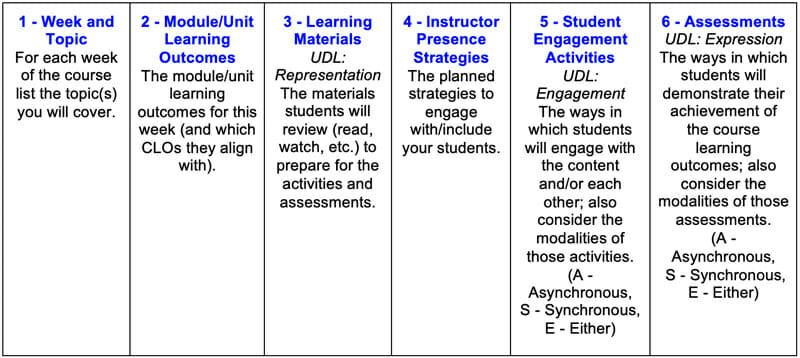
The FLIP specifically required faculty to include a variety of strategies for engagement and expression. To complete the Institute successfully, faculty needed to include at least one summative assessment where students could express their learning in more than one way. For example, students could satisfy an assignment by submitting a video, a paper, or a detailed infographic. Throughout the Institute, facilitators provided individual feedback on the FLIPs as faculty added ideas and at the end, faculty submitted their FLIPs as part of the completion requirements.
Faculty feedback
The CTL and eC2 1) asked faculty to provide feedback on their experience immediately upon completing the Institute, and 2) sent faculty a follow-up survey in the middle of the fall semester to better understand how faculty were applying the lessons of the Institute in their courses. Of the 326 faculty who completed the Institute, we had 80 responses from the survey sent immediately after their session ended (see Table 2), while 106 faculty completed the survey distributed in the middle of the fall semester (see Table 3). In both surveys a majority of faculty indicated they found the FLIP to be valuable.
In the evaluation survey distributed at the end of each summer session, when asked how much they agreed with the statement “Completing the FLIP helps me feel better prepared to deliver my course flexibly in the future,” 96 percent of faculty either strongly or somewhat agreed. Participants’ narrative comments also underscored their perception of the FLIP as a course design tool. “Creating the FLIP,” one wrote, “helped me organize my thoughts and think about activities/exercises that best meet the specific learning outcomes. It is nice to be able to look at this document and see the overview of the course in one place.” Another said “The FLIP was a fantastic tool” and “I will use it again to develop other courses.” One participant simply wrote, “It was FLIPping awesome!” In addition, faculty also identified that at the end of the experience they were able to implement the UDL principles documented in the FLIP (see Table 4).
In their narrative responses to the mid-semester survey, instructors commented on the FLIP’s ability to reduce stress and anxiety in both students and instructors, and many pointed to the alternative course materials, assessments, and activities they had prepared. One faculty member wrote, “When a student had to isolate related to a possible COVID exposure (and thus missed the first quiz), I already had an alternative assessment written.” One instructor even created a version of the FLIP for his students to use for their own articulation of and reflection on their goals for learning in his course.
Others noted that the FLIP’s insistence on UDL and student choice led them to try new strategies with great success. Some reported that making recordings of classes increased both students’ ability to keep up in class and their overall understanding. Others shared even more significant changes, noting with surprise that students built a learning community without ever stepping into a classroom or even living in the same time zone. “I have students right now in Hawaii, Maine, and California. They are safe at home, but still advancing towards their goals. These students are (hopefully) still feeling like part of a community because they get to go to breakout rooms via Zoom, [and] meet others via Flipgrid and Padlet.” One expressed their delight at how students were supporting one another’s learning by answering questions other students had asked the instructor before the faculty member even had time to respond.
Some faculty were impressed by students’ performance on assessments that were smaller, lower-stakes, more frequent, or that–in accordance with UDL principles–let students choose the format or medium by which to respond. One faculty member observed that allowing for flexibility of response in assessments had “enable[d] a higher level of participation.” Another explained, “In my [face-to-face] grad course we always had a high-stakes cumulative final exam. This fall they are doing a dozen low-stakes weekly 2-minute FlipGrid videos where each student applies some concept from the week’s lesson. I see a lot more involvement and expect the learning is much better too.” One instructor noted, “a more flexible assessment option that I’m using in one course has proven very successful in students showcasing their knowledge through their own talents and expertise rather than just through writing papers—and I was amazed at the variety and the depth in which their projects were able to go.”
Finally, the FLIP’s emphasis on UDL may have given potentially vulnerable instructors the courage or permission they needed to innovate. One adjunct wrote, “I have heard about UDL from faculty members in my program, but as someone who teaches as an adjunct and usually teaches other people’s curriculum, I didn’t know much about it. I appreciated the highlight on UDL and have made a concerted effort to include these principles into my assessments for my students in the course I’ve developed.”
Table 2: Faculty data for the summer Institute regarding the utility of the FLIP (from post-session survey) (n=80).

Table 3: Faculty data for the summer Institute regarding the utility of the FLIP (from fall mid-semester survey) (n=160).

Table 4: Faculty data for the summer Institute regarding their ability to implement UDL principles documented in the FLIP (from post-session survey) (n=80).
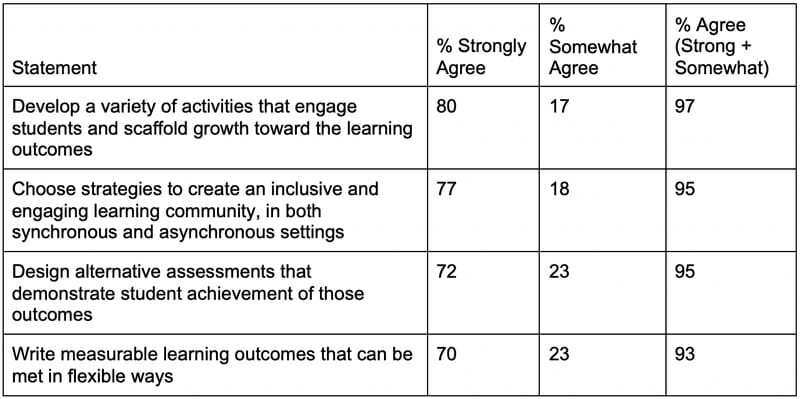
Lessons learned
While this initiative overall and the development of the FLIP in particular proved to be valuable in helping faculty prepare for teaching in fall 2020, there are a few lessons learned that will inform our work in the future:
- Provide even more flexibility. Though our evaluation responses show that faculty overall found the FLIP helpful, a few participants did provide feedback that we will use to improve the template. During the Institute, some participants expressed that they found the FLIP’s columns too constraining and requested to submit it in an alternate format. One even made a Trello board, which allowed them to drag and drop pieces of the course into different columns. And while the post-Institute evaluation data showed that faculty overwhelmingly found the FLIP to be useful, in the follow-up survey administered in mid-fall only 77 percent of the respondents indicated the FLIP was “extremely” or “somewhat helpful” in preparing them to deliver their courses—a marked decline from the 96 percent who indicated immediately post-Institute they felt the FLIP was valuable in this regard. It is unclear whether this decline in positive feedback about the FLIP is due to decreased perception of value or if it was a different subset of the participants who chose to respond to the two surveys.
At least one faculty member expressed that the structure of the FLIP contributed to a feeling of overwhelm, writing that the “FLIP asked us to consider so many [learning outcomes] and types of assignments that, when worked into my actual course this fall, it was too much.” When we use the FLIP in future offerings, we may need to build additional flexibility into its format so that participants can make it more fully their own. We also might encourage faculty to create a more concise visualization that allows them to easily view a summary of their course design and perhaps thereby make more realistic decisions about course content as well as student and instructor workload. - Be clearer about the expectations for the amount of facilitator feedback. Because the FLIP includes much more information than the traditional course design table, it does create more work both for the faculty member and the faculty developer providing feedback. Many of the FLIPs from our Institute were detailed and complex, accompanied by questions and concerns, and took significant time to read and offer useful feedback. Clarifying early on how much and how often feedback is provided on the FLIP can help set faculty expectations and avoid the burnout that some of our Institute facilitators experienced.
Moving forward
The FTSS Institute not only helped our faculty feel significantly more prepared for the fall semester, but also made us rethink our course design support going forward. Although we were initially quite reticent to let go of our typical course design table, creating something new helped both us and our faculty better respond to the moment. Helping faculty support a diverse educational community in various modalities allowed for a more inclusive approach to course design (Burgstahler, 2015).
Despite the additional work, we plan to continue using the FLIP rather than the traditional course design table for our course-design support, as it centers UDL explicitly while not ignoring the importance of alignment. Importantly, the FLIP also provides a more intentional focus on meeting diverse students’ needs, a crucial consideration for student success all of the time and in this moment specifically. Students would always have benefited from faculty flexibility, and now we have built a course-design support system that truly integrates UDL in a way that foregrounds those considerations.
We can’t go back to doing our work related to course design the way we had; we have to integrate these ideas of planning for student needs and flexibility into our work going forward. We all have become more acutely aware of the differences in students’ experiences, resources, and lives, and that knowledge brings greater empathy, understanding, and compassion to our work. Faculty in particular have had to reckon with student hardship and trauma in ways they cannot ignore as they may have been able to in the past. Giving faculty tools to better meet students where they are and plan various paths for students to achieve learning outcomes has given them more agency to plan for the complexity of students’ lives and has hopefully made them more empathetic and compassionate as well. We believe the FLIP helped make a more compelling case for adopting UDL “in order to support a diverse educational community and an inclusive approach to academic excellence” (Burgstahler, 2015, p. ix). We live in a world of uncertainty and inequity, so UDL, flexibility and student-centeredness are key to our collective future as educators.
References
Al-Azawei, Ahmed, Fabio Serenelli, and Karsten Lundqvist. “Universal design for learning (UDL): A content analysis of peer-reviewed journal papers from 2012 to 2015.” Journal of the Scholarship of Teaching and Learning 16.3 (2016): 39-56.
Aucejo, Esteban M., et al. “The impact of COVID-19 on student experiences and expectations: Evidence from a survey.” Journal of public economics 191 (2020): 104271.
Burgstahler, Sheryl. “20 Tips for Teaching an Accessible Online Course.” Disabilities, Opportunities, Internetworking, and Technology. University of Washington. (2021).
Fink, L. Dee. Creating significant learning experiences: An integrated approach to designing college courses. Revised and Updated Edition. San Francisco, Jossey-Bass, 2013.
Johnson, Nicole, George Veletsianos, and Jeff Seaman. “US Faculty and Administrators’ Experiences and Approaches in the Early Weeks of the COVID-19 Pandemic.” Online Learning 24.2 (2020): 6-21.
Miller, Michelle D. “5 Takeaways from My Covid-19 Remote Teaching.” The Chronicle of Higher Education. (2020).
Quality Matters. QM Higher Education Rubric, Sixth Edition. MarylandOnline, Inc. (2018).
Tables
Table 1: The Flexible Learning and Instruction Plan headings; an OER version of the FLIP can be found at https://bit.ly/flip-template.

Table 2: Faculty data for the summer Institute regarding the utility of the FLIP (from post-session survey) (n=80).

Table 3: Faculty data for the summer Institute regarding the utility of the FLIP (from fall mid-semester survey) (n=160).

Table 4: Faculty data for the summer Institute regarding their ability to implement UDL principles documented in the FLIP (from post-session survey) (n=80).

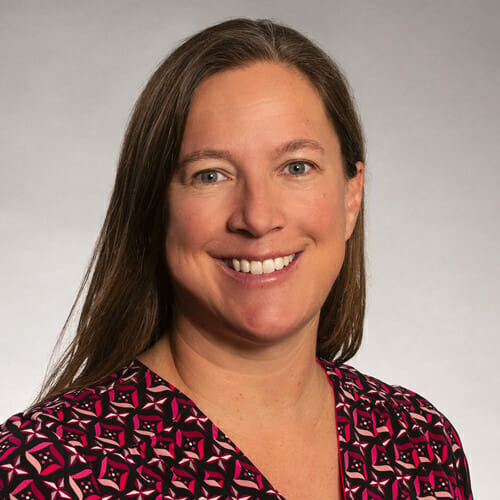 Dr. Leslie Madsen is associate director for educational development in the Center for Teaching and Learning, as well as an associate professor of History, at Boise State University.
Dr. Leslie Madsen is associate director for educational development in the Center for Teaching and Learning, as well as an associate professor of History, at Boise State University.
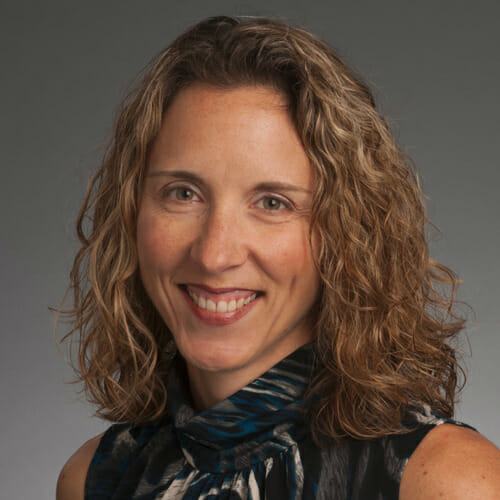 Teresa Focarile is the Interim Administrative Director of the Center for Teaching and Learning (CTL) at Boise State University. She also teaches as an adjunct faculty member in the Department of Theatre, Film and Creative Writing.
Teresa Focarile is the Interim Administrative Director of the Center for Teaching and Learning (CTL) at Boise State University. She also teaches as an adjunct faculty member in the Department of Theatre, Film and Creative Writing.
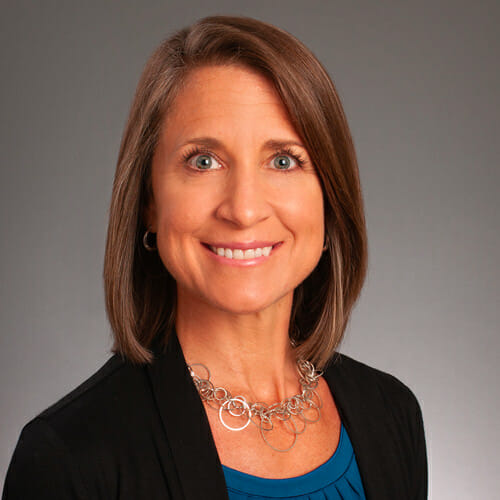 Dr. Tasha Souza is the Director of the BUILD (Boise State Uniting for Inclusion and Leadership in Diversity) program at Boise State University. She is full Professor of Communication and a consultant on DEI, communication, and pedagogy as well.
Dr. Tasha Souza is the Director of the BUILD (Boise State Uniting for Inclusion and Leadership in Diversity) program at Boise State University. She is full Professor of Communication and a consultant on DEI, communication, and pedagogy as well.
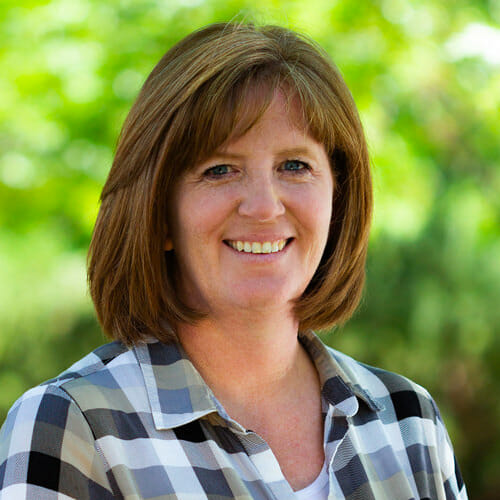 Dr. Lisa Berry is the Associate Director of eCampus Instructional Design Services. In this role, she oversees instructional design and faculty development for fully online courses offered at Boise State University.
Dr. Lisa Berry is the Associate Director of eCampus Instructional Design Services. In this role, she oversees instructional design and faculty development for fully online courses offered at Boise State University.

